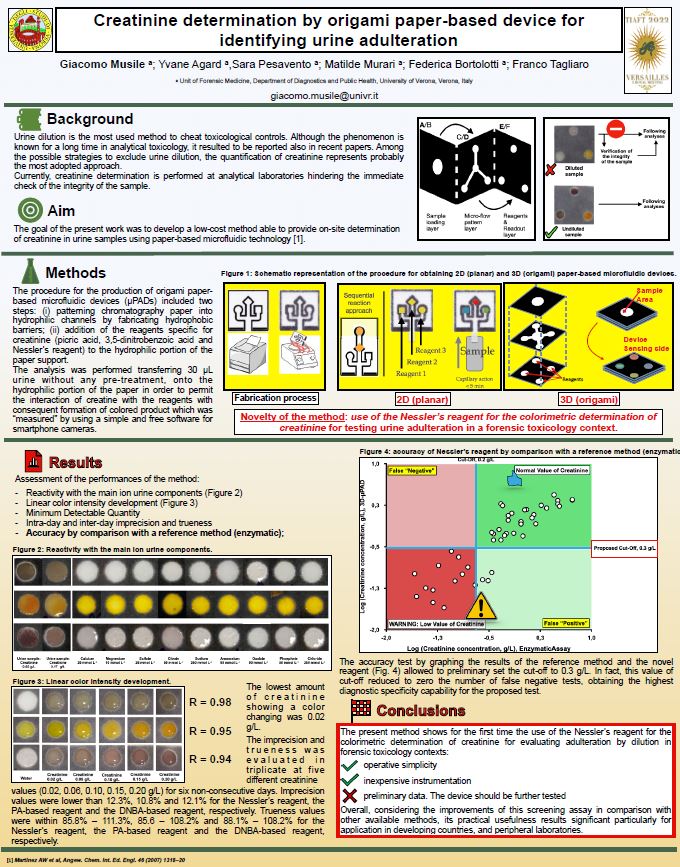Al 59th meeting TIAFT, svoltosi a Versailles nel periodo 5 – 8 Settembre 2022, il Dott. Giacomo Musile, socio GTFI, ci ha resi orgogliosi con la vincita del premio per il miglior poster con la seguente produzione scientifica:
Creatinine determination by origami paper-based device for identifying urine adulteration
Giacomo Musile, Yvane Agard, Matilde Murari, Sara Pesavento, Federica Bortolotti, Franco Tagliaro
Aim
The attendees will receive detailed information on the use of a novel tech to control the integrity of urine samples using paper-based microfluidics technology.
The problem of sample tampering is well-known in forensic toxicology being sample dilution the most used method to cheat toxicological controls. Although the phenomenon is known for a long time in analytical toxicology, it resulted to be reported also in recent papers. Among the possible strategies to exclude urine dilution, the quantification of creatinine represents probably the most adopted method.
Currently, creatinine determination is performed at analytical laboratories hindering the immediate check of the integrity of the sample.
On these grounds, the goal of the present work was to develop a low-cost method able to provide on-site determination of creatinine in urine samples using paper-based microfluidic technology [Martinez AW et al, Angew. Chem. Int. Ed. Engl. 46 (2007) 1318–20].
Method
The procedure for the production of origami paper-based microfluidic devices (μPADs) included two steps: (i) patterning chromatography paper into hydrophilic channels by fabricating hydrophobic barriers; (ii) addition of the reagents specific for creatinine (picric acid, 3,5-dinitrobenzoic acid and Nessler’s reagent) to the hydrophilic portion of the paper support.
The analysis was performed transferring 30 μL urine without any pre-treatment onto the hydrophilic portion of the paper in order to permit the interaction of creatine with the reagents with consequent formation of colored products. The colorimetric reactions occurred in few minutes and were measured in terms of “RGB distance” by using a simple and free software for smartphone cameras.
Results
The device was validated for quantitative determinations in terms of accuracy and precision, resulting both within 20%. The optimized method was then tested on real urine samples (n = 53) using as reference a clinical chemistry method performed on immunoassay instrument. The comparison between the two methods showed a significant correlation (R = 0.92).
Conclusion
The proposed alternative analytical strategy to identify urine adulteration looks particularly attractive since it is low-cost and easy to use. In addition, the possibility of performing the test on-site prevents claims of post-collection counterfeiting.

